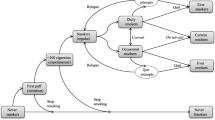Abstract
This paper offers a relatively comprehensive assessment of government anti-smoking policies (both taxation and other regulatory measures). I conclude that interventions to engender in smokers and prospective smokers an accurate perception of tobacco's health risks are justified, that except in the case of adolescents addiction by itself does not justify intervention beyond providing adequate information, that the proper goal of tobacco taxation policy should be to recoup only the extra costs that smokers place on others (at most a $1/pack tax on cigarettes), and that passive smoke's imposition of harm on unconsenting others strongly supports at least the development of a safe-to-others smokeless cigarette, if not direct intervention.
Similar content being viewed by others
References and Footnotes
One noted health economist, Michael Grossman, claims that point is $1.26 of new additional tax. Others claim it is as high as $2.24. See, For Best Revenue, Tax Cigarettes $1.16.New York Times, 18 June 1993, A-14.
Viscusi, W. K. (1992).Smoking: Making the Risky Decision, Oxford University Press, New York, pp. 7, 70, 77–80, 8, 120, 146–149.
Variations with age: older smokers, presumably less affected over the years by recent information campaigns, perceive their average loss to be less than do younger smokers who have been more affected by that information. See (2).
Rovner, S. (1991). Up in smoke: why do so many kids ignore all the evidence condemning cigarettes?Washington Post National Weekly Edition, 16–22 December, 11.
Tollison, R. D. and Wagner, R. E. (1998).Smoking and the State: Social Costs, Rent Seeking, and Public Policy, Lexington Books, Lexington, MA.
Becker, G. and Murphy, K. (1988). A theory of rational addiction.Journal of Political Economy 96(4), 675–700.
The latter is used by Oddie, G. (1993). Addiction and the value of freedom.Bioethics 7(5), 375. His discussion is critical of the alleged inherent value of freedom from addiction.
The classic statement of this view of addiction is in (7).
Goodin, R. G. (1990).No Smoking: The Ethical Issues, University of Chicago Press, Chicago, pp. 98–99, 40–41.
Warner, K. (1986). Smoking and health implications of a change in the federal cigarette excise tax.Journal of the American Medical Association 225, 1029. An additional $0.08 tax in the early 1980s would cut the incidence of smoking in 12 to 17 year olds by 11%; an additional $0.16 tax by 21%.
Manning, W. G., Keeler, E. B., Newhouse, J. P., Sloss, E. M. and Wasserman, J. (1991).The Costs of Poor Health Habits, Harvard University Press, Cambridge, p. 79. Their estimate of the difference in lifetime medical care costs between smokers and never-smokers is roughly $6000, or $1600 if discounted at 5% (p. 78). Hodgson comes to a conclusion in the same range: Hodgson, T. A. (1992). Cigarette smoking and lifetime medical expenditures.Millbank Quarterly 70, 111.
Retirement pensions have often not been regarded as ‘real costs’ by economists, but the most recent and highly regarded economic studies such as Manning have regarded them as real costs to others. See (12). See Menzel for the argument that they ought to be counted: Menzel, P. T. (1990).Strong Medicine: The Ethical Rationing of Health Care, Oxford University Press, New York, pp. 68–71, 62. The central point is that in the last analysis, the longer we live into retirement the more we have to save up to pay out in pensions, and that any ‘excess’ if we then do not live as long in a particular case constitutes a genuine saving to the others who survive. Goodin has objected to any view, including economic calculation, that views longer life as a burden on society: see (10). He sees areductio ad absurdum argument in the unacceptable implication that we might euthanise persons who burdened us with too many years of pension payouts. He sees the solution just in calculating back in the value of the longer living persons' years to themselves. For a rejection of the proposedreductio, see Menzel, P. T. (1990). As for Goodin's proposed ‘solution’, it makes a valid point about the value of life to the person who lives longer, but this is simply misplaced: in the policy contexts in which these costs are being discerned, ‘external’ net costs—net costs to others—are the proper focus in determining compensating taxes.
Manning, W. G., Keeler, E. B., Newhouse, J. P., Sloss, E. M. and Wasserman, J. (1989). The taxes of sin.Journal of the American Medical Association 261, 1606. See also the interview quotation from Manning in Passel, P. (1993). Experts wavering on steep rise in cigarette tax.New York Times, 7 June 1993, A8.
Manninget al. estimates this willingness-to-pay surrogate economic value of smokers' lives to themselves at $1.66m, or almost $5.00/pack: see (12), 1606. The $1.66m figure is on the high side in the literature; if we use $1.0m instead, and assume a considerably lower willingness-to-pay surrogate value placed on the lives of smokers by others (10% of that), we have roughly $0.35/pack additional cost to others for this item. If passive smoking deaths are 3% of smokers' deaths, that surrogate economic value is approximately $0.10. This points roughly toward the estimate of an additional $0.50/pack cost to others that I use here for the purposes of discussion.
Moss, A. H. and Siegler, M. (1991). Should alcoholics compete equally for liver transplantation?Journal of the American Medical Association 265, 10, 1295–1298.
See (2) for an insightful description and discussion of the safe cigartte.
Author information
Authors and Affiliations
Rights and permissions
About this article
Cite this article
Menzel, P. Risk perception, addiction, and costs to others: An assessment of cigarette taxes and other anti-smoking policies. Health Care Anal 2, 13–22 (1994). https://doi.org/10.1007/BF02251331
Issue Date:
DOI: https://doi.org/10.1007/BF02251331




